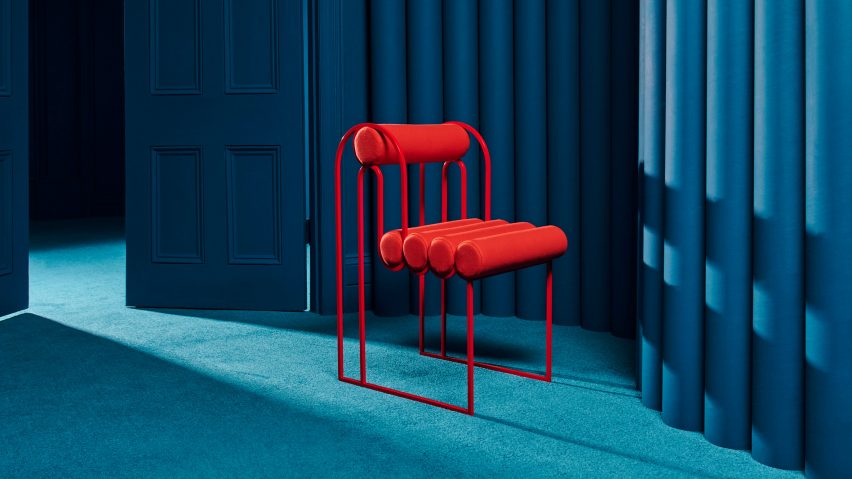London designer Lara Bohinc showcased her latest, space-themed furniture collection in a 200-year-old house in London's King's Cross that was converted into an immersive installation for the occasion.
Both a homeware collection and the house's interior were created specifically for the London Design Festival and feature Bohinc's take on celestial shapes and colours.
Bohinc also showed items from her Planetaria collection of furniture that was launched at Milan design week earlier this year, including three chairs, two pouffes, a loveseat, console and range of lights.
The new homeware range – consisting of two boxes and one vase – pays homage to the upcoming conjunction of Pluto, Jupiter and Saturn, an astrological event set to take place in January 2020.
The Saturn and Pluto box consists of three interlocking, circular brass compartments that are distinguished by lids in white calacatta, red travertine and black portoro marble.
The Jupiter vase meanwhile nods to the planets astrological association with optimism through the arched, rainbow-like shapes that form its base.
These consist of carrara marble shaped using a technology called 3D milling, whereby a three-dimensional shape can be cut from a block of material using a computer-programmed machine.
"Rather than just flat, two-dimensional cuts, with this technique you can create real depth and roundness," Bohinc told Dezeen. "It's a difficult process because marble it's very hard and brittle, so it's easy to break."
Nestled within this frame is a brass cylinder meant for holding flowers, which can be removed from its stand in order to be refilled.
Finally, the Juno box adds an element of green ming marble to the colour palette of the other pieces, in order to give the otherwise geometric design a softer, feminine spin.
To showcase the collection, Bohinc transformed the kitchen of an 18th-century townhouse in the King's Cross area in London into her interpretation of a space station, called Lunar House.
The bay windows and white stucco front of a classic Victorian house stand in stark contrast to the petrol blue colour of the floors and ceilings as well as the walls, which are clad in tubes to match the design of the furniture.
"To us, the cosmos looks blue, and from space, Earth appears blue," said Bohinc. "So I wanted to have the whole room covered in this same colour."
Dotted against the cosmic backdrop are the pieces from Bohinc's Planetaria collection, that are made up of her trademark tubular and spherical shapes.
Lunar House marks the first time the designer has presented her works within a full interior set-up.
"We usually show at trade shows, but this allows us to highlight the pieces in a more immersive environment," explained Bohinc. "I think you see the soul of a piece a lot more when it's placed in someone's house rather than in a show room."
This also allowed the designer to play with two other key elements, sound and smell: "Sound and smell always bring a different dimension to a space that you can't totally pinpoint. I wanted it to be an otherworldly experience," she said.
Bohinc commissioned musician Pandora's Jukebox to create one of the "hypnotic dreamscapes" that she is known for, that incorporate some of the sounds and vibrations that have been recorded by NASA during space missions.
For the scent, she used an earthy perfume called Twisted Iris courtesy of perfume designer Azzi Glasser that emulates the smell of plants.
"Apparently what astronauts miss most when they are in space is nature, living things, plants," she said.
Bohinc's love of all things celestial can also be found in a number of other recent collections including a series of tables modelled after the geometry of planetary orbits and a sphere-heavy seating collection entitled Since the World is Round.
The designer thinks that her fascination with space must have something to do with escapism.
"The cosmos is something that's always been there and will always be there," she said. "It's a constant. It has changed throughout history but throughout our lifetimes it probably won't. So it's almost like a safe haven."
Photography is by Philippe Fragniere.

